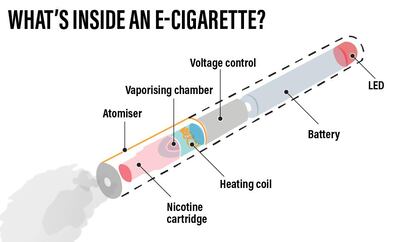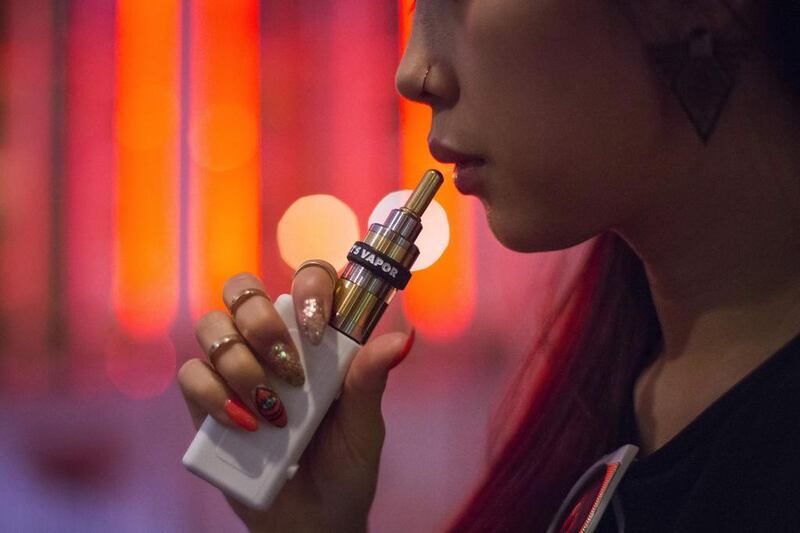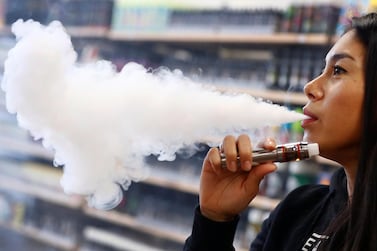Legalising the sale of e-cigarettes in the UAE could open the door for more young people to take up vaping due to peer pressure and normalisation, experts have said.
Within 24 hours of the announcement that the previously prohibited sale of vaping products is to be lifted, teachers and doctors have expressed concern that it will have a negative impact on the future health of young people in the country.
The lifting of the ban will allow authorities to regulate the industry and crack down on the black market, which has allowed thousands of illegally imported devices to be sold under the counter in the UAE.
But some warn the decision could encourage more young people to get hooked on nicotine.
Children are vulnerable to succumbing to peer pressure and risk damaging their long-term health, with medical experts still unsure of the impact of vaping.
Dr Hassan Mohamed Aref Shabana, a respiratory consultant at Zulekha Hospital, Sharjah, warned that e-cigarettes could be a gateway to using tobacco products.
“In countries where vaping is allowed, school age pupils who were never smokers before have taken up vaping,” he said.
“This increases the number of those with nicotine addiction at a young age, who will possibly shift towards regular cigarettes later in life.”
Although Dr Shabana backed the new rules as they will make the products safer as an alternative to smoking, he has concerns over their attractiveness to young people.
“Vaping may increase nicotine dependence and addiction as it does not have a lasting smell. It can be used in cars, offices, planes and trains, without the smell or social stigma," he said.
“E-cigarettes tend to be used more than a conventional cigarette, leading to higher nicotine intake and greater dependence.
“The long-term health damage may be seen only after many years of use.”
Research published in 2018 by the American Academy of Pediatrics found that ‘open’ vaping devices — those that are rechargeable and have liquid refills — were by far the most popular devices used by adolescents.
The vaping habits of more than 25,000 young people in the US were assessed over a 30-day period for the Population Assessment of Tobacco and Health Study.
It found the majority of adolescents used starter products when first taking up vaping, which are on the cheaper end of the market and have weaker quality controls.
That trend could increase the health risks to young people, researchers said.

Deepika Thapar Singh, principal at Credence High School in Dubai, said schools must be vigilant of the vaping trend and offer education to pupils as devices become more accessible.
“The temptation will be stronger, the availability will be easier and addiction will only increase,” she said.
“I have seen teenagers getting into vaping as they feel it is important to fit in and be cool.
“Now they will see people around them of the same age vaping and it will become even more acceptable.”
Ms Singh said open discussions in school revealed children felt peer pressure compels them to take up vaping, and she backs an age restriction of 21 for sales.
"People think it's a quick way to stop smoking,” she said.
“That’s extremely dangerous as it is not the real story — you are moving from one addiction to another.”
In the UK, where e-cigarettes have been backed by Public Health England as being 95 per cent less harmful than traditional tobacco products, more young people are taking up vaping.
Scientists have followed up on US research to conduct their own study on youth trends, published in the British Medical Journal.
They found e-cigarette use among teenagers was relatively low, but the proportion of young people who had tried vaping was reasonably high at between 13 and 22 per cent.
The research included surveys of 2,386 pupils aged between 13 and 14 from 20 schools across England.
Pupils who said they had never smoked cigarettes but had vaped were asked again 12 months later if they had tried tobacco and 34.4 per cent said they had, with 9 per cent saying they went on to become smokers.
The study’s authors said more research was needed to make a more comprehensive conclusion on any link between vaping and a gateway to tobacco.
In the UAE, tobacco and shisha products carry an age restriction of 18, but it is not yet clear if the same restrictions will apply to vaping.
Ron Hodkinson, principal at Ontario International Canadian School, also backs an age restriction on vaping products.
"Having laws is one thing but we need to educate pupils,” he said.
"There is pressure on young people and adults.”
The National Institute of Health in the US found a huge increase in teens' use of vaping devices.
In 2018, 37.3 per cent of 12th graders had tried vaping while in 2017, that number stood at 27.8 per cent.
“They know it is wrong, but they may not know of the negative health impact,” said Mr Hodkinson.
“Children must be educated to make informed decisions for themselves.”
Although long-term studies on the physiological effects of vaping are few, doctors have reported respiratory problems in users.
Parents also expressed concerns over that the new rules would mean easier access for children.
“At 18, young people are still growing and just want to be cool in front of their friends,” said Joanna Balkis, a Lebanese mother of two working in Dubai.
"This is dangerous and worrying."






